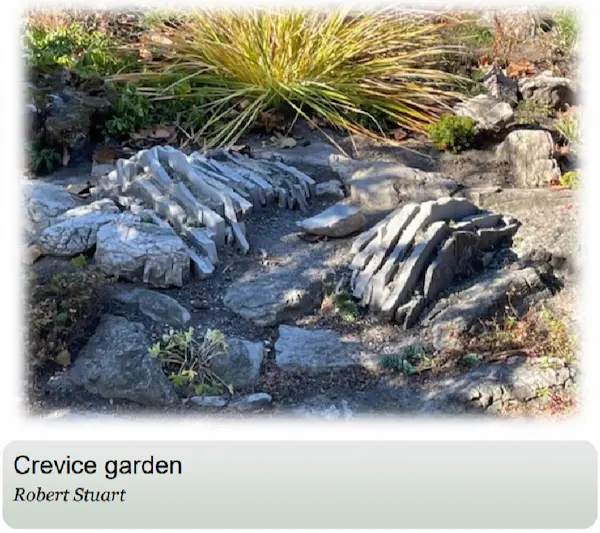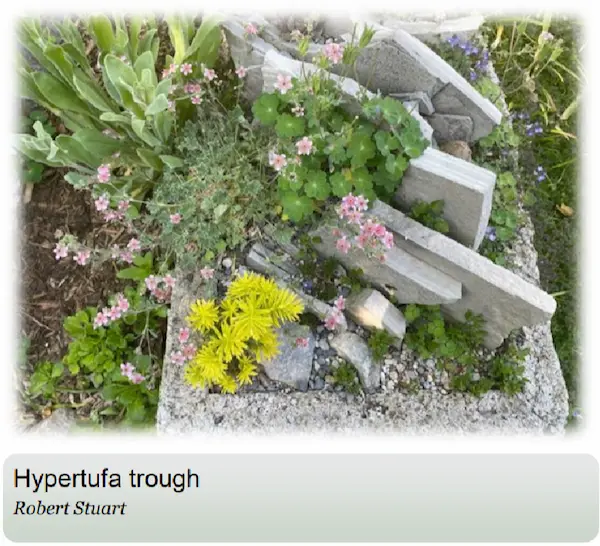Growing Alpine Plants, aka Rock Gardening: Getting Started
Many gardeners are familiar with growing vegetables, shrubs, trees and ornamental flowers that require soil of moderate fertility. When planning to grow alpine plants, the growing conditions are significantly different.
A Brief History of Rock Gardens
Intrepid gardeners began travelling to Europe in the middle 1800s, exploring alpine plants of the Alps, Caucasus, and Pyrenees mountain ranges. They found these alpine plants very attractive and decided that they wanted to grow them in their own gardens.
Initially, they removed mature specimens from the mountains, transplanted these into their existing lowland gardens, and experienced failure. They did not understand the environment where these plants had evolved. Many of these plants grew at high altitudes above the treeline, where they were exposed to intense sunlight, poor mineral soil, steady winds, and continuous cold and snow during the winter.
Only after examining their failures did they begin to understand the conditions these plants needed to grow and thrive. To survive the intense sunlight, many plants developed silver or light-coloured leaves to help reflect the intense rays and often grew in sheltered crevices where they were subjected to direct sunlight only part of the day. Most plants only grew to a small size since there weren’t a lot of nutrients in the poor mineral soils. As a result, unlike plants growing in fertile valleys, they produced fewer and smaller leaves, and as a consequence, very little humus built up around their crowns.
Additionally, strong winds forced plants to huddle close to the ground for protection. Some species evolved long hairs on their leaves to help maintain whatever heat they could collect. Due to the lack of humus in the soil, these plants were used to very free-draining soils. When the snow began to melt in spring, those soils kept the crowns of the plants from sitting in pools of water and rotting out. Even if there were brief thaws during the winter months, the resulting water drained away quickly.
Knowledge-Based Rock Garden Design
So, with these facts learned, the early rock gardeners modified their gardens. They began using mixtures of poorer soil that included significant proportions of sand and gravel and lesser proportions of humus. They organized their gardens to reflect the types of environments found in the mountains, with both large and smaller rocks positioned to give different light exposures and provide narrow but deep cracks that allow roots to reach the moisture below the surface.
Water Considerations
They understood that in a mountainous environment there is a relatively continuous source of moisture available, not just via rains but via the daily production of dew that results from fluctuations of temperatures overnight. Using this last fact, they understood that newly transplanted plants require a regular supply of water until they develop the long roots needed to access moisture deep below the surface. All of these factors contributed to where rock gardening is today. In the early 1990s, Czechs introduced North Americans to the term crevice gardening, although there were references in the Alpine Garden Society’s first journal in 1930 to placing stones in a vertical position.
Crevice Gardens
Since the early 90s, large crevice gardens have been built throughout North America in public and private settings. The Montreal Botanical Garden (MBG) has two crevice gardens, the first one built in 2002 in conjunction with Czech Josef Halda and the second built in 2005 in conjunction with another Czech, Zdenek Zvolanek. The second garden uses the vertical positioning of ‘flat’ stones, leaving crevices up to 2.5 cm in width in which to insert the bare-root alpine plants. The stones are placed in such a manner as to create a mound raised above the existing soil surface, which also helps to provide superior drainage. As the garden was built, a mixture of’soil’ consisting of two parts garden loam, two parts sand, one part 1 cm-sized gravel, and one-half part garden compost was placed into the crevices and firmed in place. Heavier stones placed at the edges of the crevice structure provided support for the vertical stones. This garden at the MBG has remained in its just-built state from 2005 until today.

This approach also lends itself to the creation of smaller crevice gardens in our yards and even to the creation of crevice gardens in hyper-tufa troughs (medium to large containers made of Portland cement, peat moss, and perlite). These crevice gardens provide an excellent environment for growing alpine plants, which require superior drainage to prevent their crowns from rotting, especially during winter when they may be subjected to freeze-thaw cycles.

In the summer of 2022, a small demonstration crevice garden was built in the ornamental gardens at the Central Experimental Farm. It consists of two parts: one aligned in an east-west direction and the other aligned in a north-south direction. When the gardens were inspected in spring 2023, all but one of the twenty or so plants had survived the winter, which is an excellent result. Since the crevices are quite narrow, all plants had to be planted in a bare-root manner, as a large rootball would not fit into such a narrow space. This, however, has two advantages: the first is that the plant’s roots quickly adapt to the new soil environment and secondly, it allows the roots to be placed deep within the crevice where the soil temperature remains consistent and moisture is more available. Additional alpine plants will be added to this garden as they become available and space permits.
If you get the opportunity to visit the Central Experimental Farm’s ornamental gardens, be sure to take a look at this new type of rock gardening. Also, if you are interested in learning more about rock gardening, you might want to consider joining the Ottawa Valley Rock Garden & Horticultural Society, whose main focus is rock gardening, although other types of gardening are also covered.







Leave a Reply
You must be logged in to post a comment.